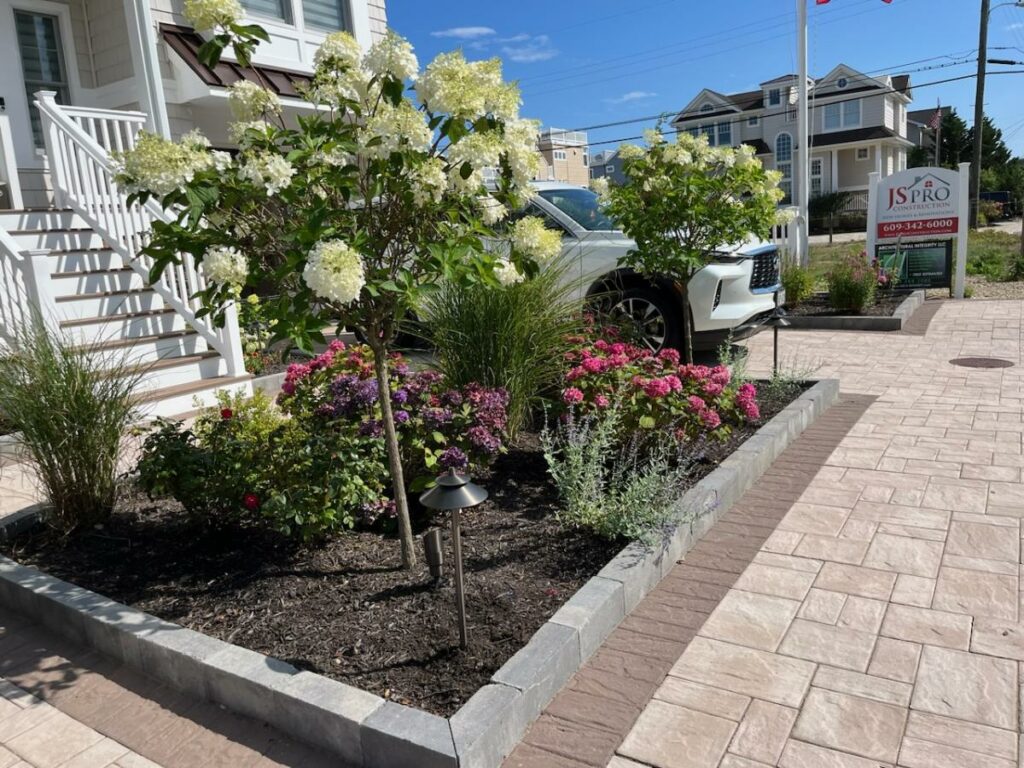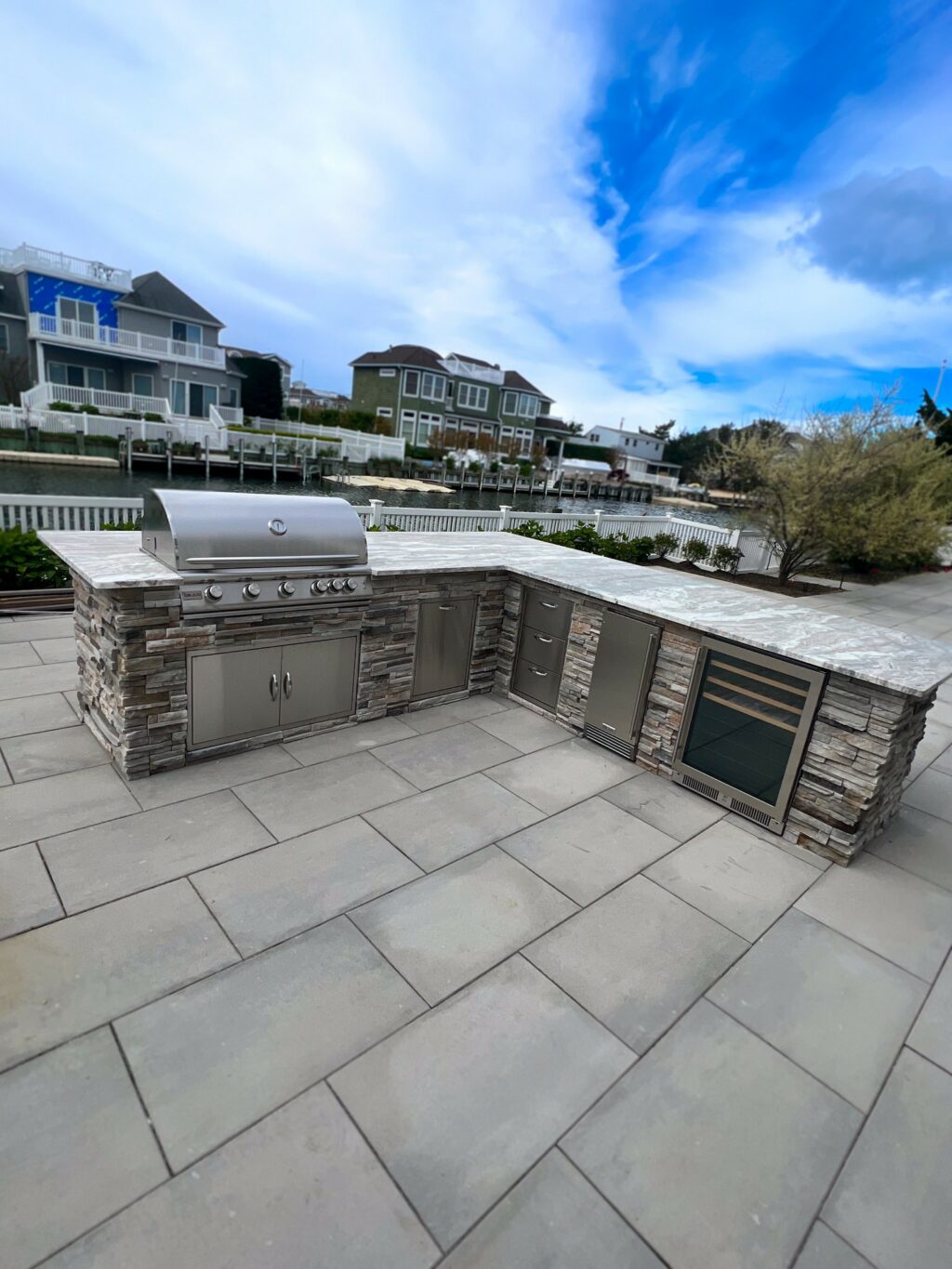When it comes to enhancing your outdoor space, choosing the right patio material is crucial, especially in the unique climate of the Jersey Shore. Two popular options are paver and concrete patios. Each has its advantages and drawbacks, but which one truly stands the test of time? In this comprehensive guide, we will explore the longevity, durability, maintenance, cost, and aesthetic appeal of both materials to help you make an informed decision for your outdoor oasis.
Understanding Paver Patios

Paver patios are constructed from individual stones or bricks, allowing for a variety of designs and patterns. These patios are known for their aesthetic appeal and versatility.
Benefits of These Patios
- Durability: Pavers are designed to withstand various environmental conditions, making them ideal for coastal areas prone to moisture and erosion. The individual stones can shift slightly, allowing for flexibility and reducing the risk of cracking.
- Ease of Repair: If a paver is damaged, it can be easily replaced without affecting the surrounding stones. This flexibility makes paver patios a practical choice for homeowners who want to maintain their outdoor space without extensive repairs.
- Variety: Available in various shapes, sizes, and colors, pavers allow homeowners to customize their outdoor space creatively. This variety means you can create unique patterns and designs that enhance the visual appeal of your patio.
- Natural Aesthetics: Pavers provide a more natural look compared to concrete, blending seamlessly with the landscape. This aesthetic quality is particularly appealing for homes near the shore, where natural elements play a significant role in design.
- Permeability: Many pavers are designed to be permeable, allowing water to drain through the joints. This feature helps reduce runoff and minimizes the risk of flooding, making them an environmentally friendly option.
Considerations for Paver Patios
- Installation: While paver patios offer numerous benefits, their installation can be more labor-intensive and time-consuming than concrete. It requires a solid base, careful planning, and skilled labor to ensure proper alignment and drainage.
- Cost: The initial cost of paver patios is generally higher than concrete, but the long-term benefits often outweigh the upfront investment.
Understanding Concrete Patios

Concrete patios are made from a solid slab of concrete, providing a seamless and durable surface. They are often chosen for their cost-effectiveness and straightforward installation.
Benefits of These Patios
- Cost-Effective: Generally, concrete patios are less expensive to install than paver patios, making them a popular choice for budget-conscious homeowners. The lower material costs and quicker installation time contribute to overall savings.
- Low Maintenance: Concrete requires minimal upkeep, typically needing only occasional cleaning and sealing. This low-maintenance aspect appeals to homeowners looking for a hassle-free outdoor space.
- Longevity: When properly installed and maintained, concrete patios can last for many years, often exceeding 30 years. This durability makes them a reliable option for homeowners seeking long-term solutions.
- Versatile Design Options: While traditional concrete is often seen as plain, modern techniques allow for decorative finishes such as stamping, staining, and coloring. These options provide homeowners with opportunities to enhance the visual appeal of their concrete patios.
- Uniform Surface: Concrete offers a smooth, even surface that can accommodate various furniture and activities. This uniformity is beneficial for entertaining, dining, and other outdoor activities.
Considerations for Concrete Patios
- Cracking Issues: While concrete is strong, it can crack under pressure or if the ground shifts. This is particularly relevant in sandy or unstable coastal areas. Homeowners should be prepared to address any cracks or damages promptly.
- Limited Flexibility: Unlike paver patios, concrete is a rigid material that does not allow for movement. As a result, if settling occurs, it can lead to significant cracking or damage.
Longevity Comparison: Paver vs. Concrete
Paver Patio Longevity
- Lifespan: Paver patios can last anywhere from 25 to 50 years with proper care. Their individual stones can shift slightly, allowing for flexibility and reduced cracking. This adaptability is particularly important in coastal areas where ground movement may occur.
- Environmental Resistance: Pavers are more resistant to harsh weather conditions, which is crucial for the Jersey Shore’s coastal climate. They can handle moisture, salt exposure, and temperature fluctuations better than concrete.
- Maintenance Impact: Regular maintenance, such as cleaning and re-sanding joints, can extend the life of paver patios. Homeowners who invest time in upkeep will benefit from the longevity and beauty of their paver installation.
Concrete Patio Longevity
- Lifespan: Concrete patios can last 30 years or more if well-maintained. However, they are more susceptible to cracking due to ground movement and temperature fluctuations. The lifespan may vary based on installation quality and environmental factors.
- Cracking Issues: While concrete is strong, it can crack if not installed correctly or if the ground shifts. This is especially relevant in sandy coastal areas where instability is more common.
- Sealing and Maintenance: Proper sealing and maintenance can significantly impact the longevity of concrete patios. Homeowners should be proactive about addressing cracks and applying sealant to protect against moisture and stains.
Maintenance Considerations
Paver Patios
- Routine Maintenance: Regular cleaning and occasional re-sanding of joints are necessary to prevent weed growth and maintain the patio’s appearance. A power washer can effectively clean the surface, removing dirt and debris.
- Sealing: Applying a sealant every few years can enhance the durability and appearance of pavers. Sealants protect against stains, fading, and moisture damage, ensuring that your patio looks great for years to come.
- Weed Control: Keeping the joints free of weeds is essential for maintaining the integrity of the patio. Homeowners can use polymeric sand to fill joints and prevent weed growth effectively.
Concrete Patios
- Crack Repair: Promptly addressing cracks with a concrete filler can extend the life of your patio. Ignoring small cracks can lead to larger, more expensive repairs down the line.
- Sealing: Like pavers, sealing concrete surfaces can protect against moisture and stains. A quality concrete sealant can help prevent damage from salt and water, especially in coastal environments.
- Regular Cleaning: Regular sweeping and occasional pressure washing can keep concrete patios looking clean and inviting. Stains should be addressed immediately to prevent them from setting in.
Aesthetic Appeal
Paver Patio Aesthetics
- Custom Design Options: Paver patios allow homeowners to create unique designs that complement their landscaping and home architecture. The wide variety of colors, shapes, and patterns available means that each of these patios can be distinctly customized.
- Natural Look: The individual stones provide a more organic appearance compared to concrete, blending seamlessly with the natural surroundings. This aesthetic quality is particularly appealing for homes near the shore.
- Versatility: Pavers can be arranged in numerous patterns, such as herringbone, basketweave, or running bond, allowing for creative expression and personalization.
Concrete Patio Aesthetics
- Modern Finishes: While traditional concrete may be perceived as dull, modern techniques such as stamping, staining, and engraving allow for a variety of decorative finishes. These options can replicate the look of natural stone or brick, enhancing the visual appeal of concrete patios.
- Color Options: Homeowners can choose from a range of colors and textures to create a concrete patio that complements their home’s exterior. This flexibility allows for creative design while maintaining the durability of concrete.
- Uniform Look: Concrete offers a smooth, even surface that can accommodate various furniture and activities. This uniformity is beneficial for entertaining, dining, and other outdoor activities.
Cost Comparison
Paver Patio Costs
- Initial Investment: The cost of paver patios can be significantly higher than concrete, depending on the type of pavers chosen, the complexity of the design, and the installation process. On average, homeowners can expect to pay between $15 to $30 per square foot for paver installation.
- Long-Term Value: While the initial investment may be higher, the longevity and low maintenance of paver patios often justify the cost. Homeowners who prioritize aesthetics and long-term durability may find paver patios to be a worthwhile investment.
Concrete Patio Costs
- Initial Investment: Concrete patios are typically more affordable, ranging from $6 to $15 per square foot. The lower material costs and quicker installation time contribute to overall savings.
- Long-Term Costs: Although concrete patios have lower initial costs, potential issues with cracking and required maintenance can lead to additional expenses over time. Homeowners should consider the long-term costs associated with repairs and maintenance when evaluating their budget.
Environmental Considerations
Paver Patios
- Permeability: Many pavers are designed to be permeable, allowing water to drain through the joints. This feature helps reduce runoff and minimizes the risk of flooding, making them an environmentally friendly option.
- Sustainability: Pavers are often made from natural materials and can be recycled, contributing to sustainable building practices. Choosing pavers can align with environmentally conscious decisions for homeowners looking to reduce their ecological footprint.
Concrete Patios
- Heat Absorption: Concrete can absorb and retain heat, which may lead to increased temperatures in outdoor spaces. This can affect the comfort level of outdoor living areas, especially during hot summer months.
- Sustainability: While concrete is a durable material, its production process can have a significant environmental impact due to high energy consumption and CO2 emissions. Homeowners concerned about sustainability should weigh these factors when choosing their patio material.
Which is the Better Choice?
Both paver patios and concrete patios offer unique benefits and can last for many years with proper maintenance. However, if you’re looking for a patio that can adapt to the Jersey Shore’s environment and offer flexibility in design, a paver patio may be the better option. The longevity, ease of repair, and aesthetic appeal make pavers a compelling choice for many homeowners.
Conversely, if you prioritize lower initial costs and straightforward maintenance, a concrete patio could be the way to go. However, homeowners should be prepared for potential cracking and the need for repairs over time.
Ultimately, the decision comes down to your personal preferences, budget, and long-term goals for your outdoor space. By carefully evaluating your options and considering the specific conditions at the Jersey Shore, you can choose a patio that not only meets your aesthetic preferences but also stands the test of time.
Ready to enhance your outdoor space? Visit Jersey Shore Pavers today to explore our wide selection of paver options and discuss your patio project with our experts!



